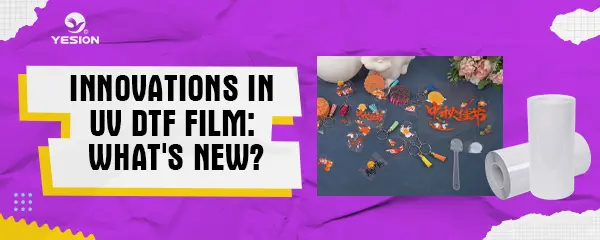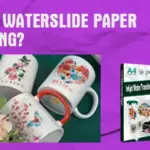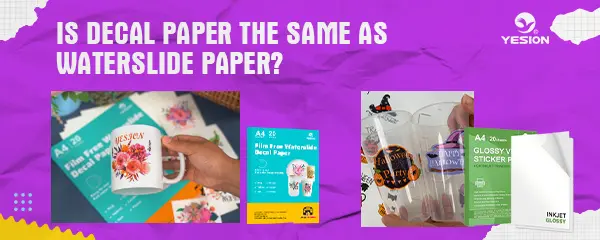
Innovations in UV DTF Film: What’s New?
2024-11-08
Why is my waterslide paper not sticking?
2024-11-15In the world of crafting and custom designs, decal and waterslide papers are two highly popular materials. They’re often used for customizing items like mugs, phone cases, candles, and even model kits. But are these two types of paper the same? In this blog, we’ll explore what decal paper and waterslide paper are, their differences, and when to use each type.
What is Decal Paper?
Decal paper is a specially designed material used to transfer printed images or designs onto various surfaces. The process usually involves printing on the decal paper, trimming the design, and transferring it onto the object. Decal paper can come in different forms, depending on the type of adhesive or transfer process. Common types of decal papers include:
Inkjet Decal Paper: For use with inkjet printers.
Laser Decal Paper: For use with laser printers.
Vinyl Decal Paper: A thicker, waterproof option often used for outdoor applications.
Decal paper typically has an adhesive layer that activates during the transfer process, allowing the printed design to stick to the intended surface.
premium Printable Vinyl Sticker Paper for Inkjet Printer
What is Waterslide Paper?
Waterslide paper, a type of decal paper, is known for its unique transfer method: water. Waterslide paper is commonly used in crafts, DIY projects, and model making. The waterslide process involves soaking the paper in water to release the design, which can then slide onto the surface of the object. Types of waterslide paper include:
Clear Waterslide Paper: Has a transparent background, ideal for light surfaces.
White Waterslide Paper: Has a white background, suitable for dark surfaces where a clear background wouldn’t show well.
How Are Decal Paper and Waterslide Paper Different?
While waterslide paper is technically a type of decal paper, not all decal papers are waterslide. Here’s a quick comparison to help clarify the differences:
1. Transfer Method
Decal Paper: Often requires heat, pressure, or adhesive for transfer.
Waterslide Paper: Activated by water, which allows the design to slide off the backing paper.
2. Adhesive Layer
Decal Paper: Can come with an adhesive backing that sticks to surfaces upon transfer.
Waterslide Paper: Relies on the water-activated slip layer, which does not have adhesive.
3. Ease of Use
Decal Paper: Varies by type. Some types require heat presses or complex application methods.
Waterslide Paper: Generally easier to work with since it only needs water to activate.
4. Finish and Durability
Decal Paper: Comes in a variety of finishes and thicknesses; it can be long-lasting depending on the type.
Waterslide Paper: Typically has a thin, delicate layer that’s best for indoor use.
Pros and Cons of Using Decal Paper
Pros:
- Versatility: Works on a wide range of materials, from plastic to metal.
- Durability: Many decal papers offer a long-lasting finish that withstands regular handling.
- Variety of Options: Decal paper is available in different types for inkjet, laser, or vinyl applications.
Cons:
- Requires Special Equipment: Certain decal papers need heat presses or adhesives.
- More Complex Application: Some types can be tricky for beginners.
Pros and Cons of Using Waterslide Paper
Pros:
- Easy to Use: The water-activated transfer is beginner-friendly.
- Smooth Finish: Waterslide decals often give a professional-looking, seamless finish.
- Great for Detailed Designs: Ideal for intricate designs that need precise placement.
Cons:
- Less Durable: Waterslide paper is sensitive to water and moisture, making it less suitable for outdoor or high-use items.
- Surface Limitations: Works best on smooth, non-porous surfaces.
How to use yesion inkjet clear water decal paper?
When to Use Decal Paper vs. Waterslide Paper
Use Decal Paper When:
- You need a durable, adhesive-backed transfer.
- You’re working on items that will be handled or washed frequently.
- You want a more permanent solution, such as custom stickers or outdoor signage.
Use Waterslide Paper When:
- You’re decorating items with complex shapes, like model cars or figurines.
- You want a seamless, professional finish on glass, ceramics, or candles.
- Your project will be indoors and not exposed to moisture regularly.
Key Tips for Using Both Types of Paper
1. Choose the Right Printer: For inkjet decal paper, make sure to use an inkjet printer. For laser decal paper, use a laser printer. For waterslide paper, the type will depend on your printer too.
2. Seal Your Design: For waterslide paper, spray a clear acrylic sealer on the printed side to prevent the ink from bleeding when submerged in water.
3. Allow for Curing Time: With either type, especially waterslide decals, let the finished item dry and set fully for optimal durability.
4. Protect Your Work: If the item will be used frequently, consider applying a protective clear coat or resin for longevity.
In short, while all waterslide papers are decal papers, not all decal papers are waterslide papers. Decal paper covers a broader category that includes waterslide, vinyl, and adhesive decals, each with its own transfer methods and purposes. Understanding these differences can help you select the best option for your project and ensure that your designs not only look great but last.
Related:
Is sticker paper the same as decal paper?
Choosing the Perfect Waterslide Decal Paper

